New Mexico’s deserts house many epic animals, from mammals to insects and birds to reptiles, but which are the deadliest of all? Discover the eleven most dangerous animals in New Mexico’s deserts.
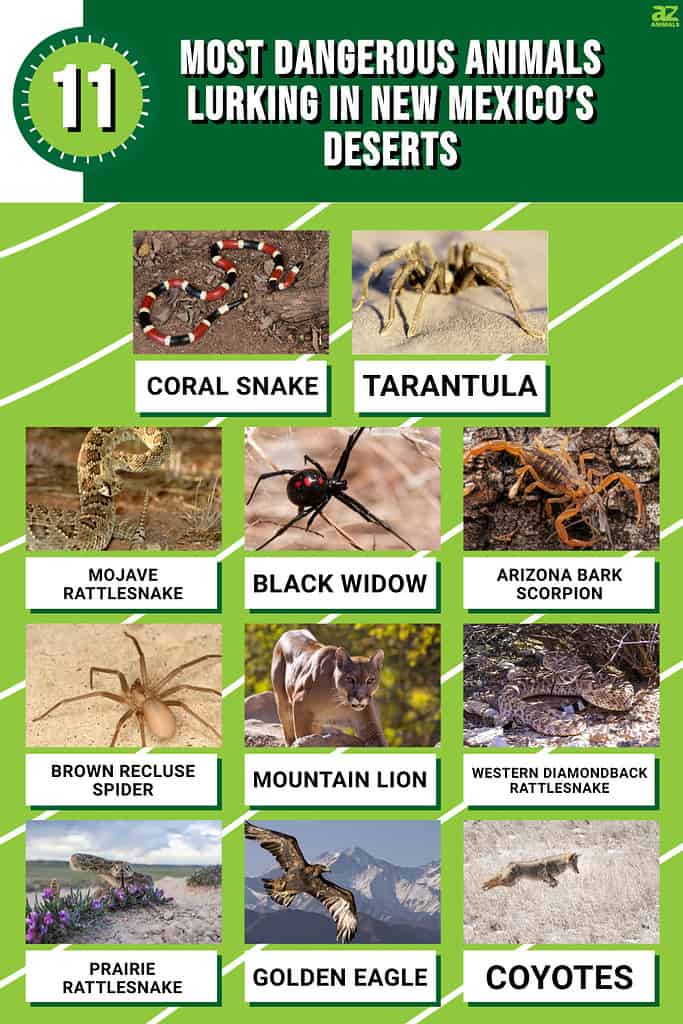
What Are the Deserts in New Mexico?
North America’s largest desert, the Chihuahuan Desert, stretches across six states, including New Mexico. It’s 175,000 square miles of sand, scrub, and mountains that range from 1,000 to 10,000 feet above sea level. Daylight hours are scorching, but during winter, the temperatures fall below freezing.
This epic New Mexico desert receives more summer rain than America’s other deserts, the Sonoran, the Mojave, and the Great Basin, and it’s colder there during winter. One of the Chihuahuan desert’s best-known areas is the White Sands National Park situated in New Mexico. It’s a popular tourist spot in summer and winter.
Another incredible New Mexico desert is the De-Na-Zin wilderness, a 45,000-acre desert in San Juan County. It’s called the Badlands and managed by the Bureau of Land Management. A small area of Navajo land sits inside the desert. Visitors say this is the most scenic desert New Mexico offers. It’s a three-hour drive from Albuquerque.

The Chihuahuan Desert is the largest desert in New Mexico.
©Jeffrey M. Frank/Shutterstock.com
So, what dangerous animals lurk in New Mexico’s deserts?
1. Coral Snake
Pretty little coral snakes live in New Mexico deserts and for their size, they pack a huge punch of venom, which is enough to kill a human. However, their short fangs generally aren’t long enough to penetrate clothing and/or skin.
Coral snakes reach 11 – 20 inches long with thick red and black bands divided by thinner yellow bands, which means they’re highly visible. These deadly snakes spend their time lurking beneath boulders and rocky outcrops. Their main prey includes rodents and other snakes including rattlesnakes, but they’ll take advantage of birds or insects within reach too.
Despite their showy colors, elusive coral snakes don’t appreciate human contact, and they emerge to hunt in the cool evenings as night falls.
Coral snakes are one of the most dangerous animals in New Mexico’s deserts. If you ever spot one, back away, and it’ll make its escape. These epic snakes don’t hunt humans or their pets, but they will strike if threatened or hurt. Most coral snake bites occur when someone picks one up. Don’t be this person.
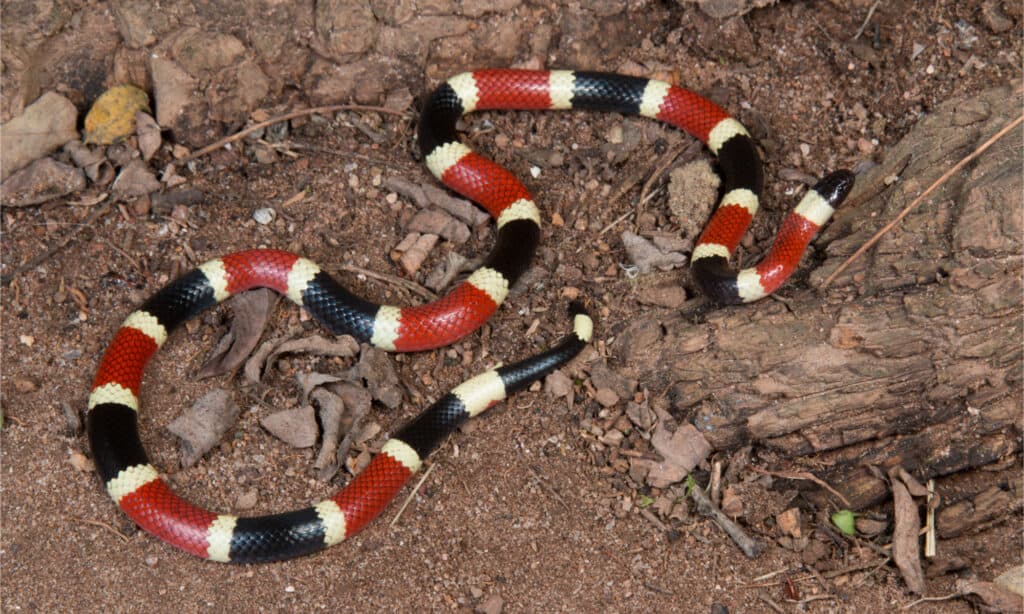
New Mexico’s coral snakes live beneath boulders and rocky outcrops.
©Nathan A Shepard/Shutterstock.com
2. Tarantula
Desert tarantulas usually keep themselves in burrows and head out at night to capture their insect prey, but in fall tarantulas head out to find a mate. In September and October, it’s pretty common to see tan and brown tarantulas on the desert trail looking for a date.
Tarantulas capture prey with a venomous stinger that incapacitates their unfortunate victim, so they can drag it back to their burrow to eat at leisure. It’s very rare that this spider’s bite will kill a person, but it’s incredibly painful to endure and causes nasty wounds.
Male tarantulas live until they’ve mated, but females live for 25 years. Yes, they do sometimes eat their mate, but that’s not unusual for opportunistic hunting spiders. Tarantula’s top predators are tarantula hawk wasps. These wasps don’t kill or eat tarantulas but lay an egg inside the hapless tarantula’s body, which later hatches and eats its way out.
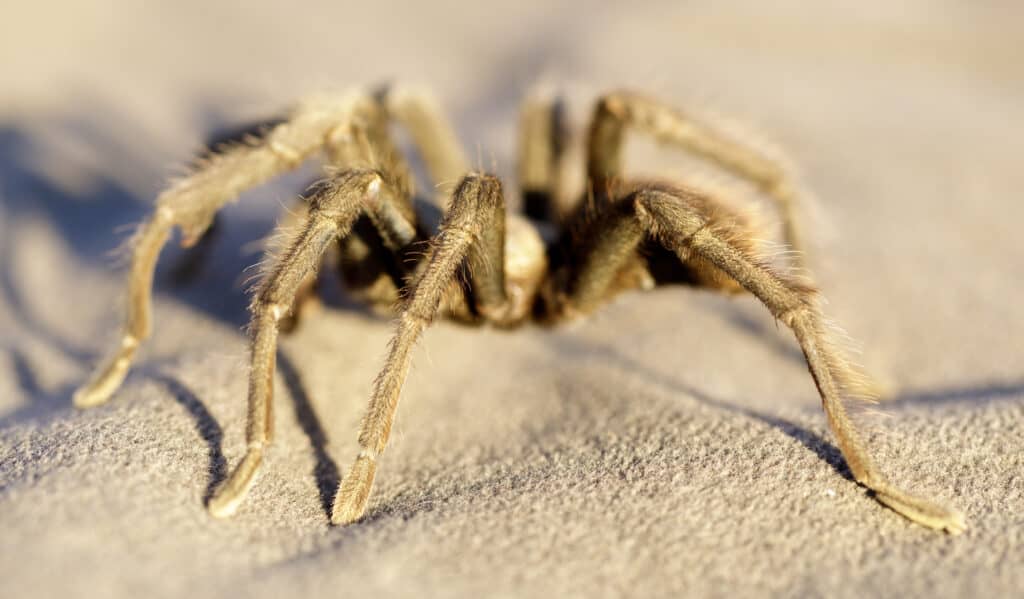
Tarantulas leave their burrows in the fall when it’s time to find a mate.
©iStock.com/yhelfman
3. Mojave Rattlesnake
New Mexico’s desert houses several species of venomous rattlesnakes. The first on our list is the Mojave rattlesnake, a five-foot-long highly venomous pit viper, which despite its name also lives in New Mexico’s deserts. This snake is especially dangerous because its potent venom can kill humans. That said, only two people have died from its bite since 1960, so it’s not a common occurrence.
Mojave rattlesnake hunt rodents in New Mexico’s deserts. They chiefly emerge at night, but won’t pass up a meal if it passes by during the day. Desert hikers report rattlesnakes to sunbathe, but they disappear quickly when humans approach. Their habit of sunbathing makes them prey to epic birds such as the golden eagle and hawks that circle above.

Mojave rattlesnakes hunt rodents in the desert at night.
©Shoemcfly/iStock via Getty Images
4. Black Widow
Surely everyone has heard of the black widow spider, thanks to Marvel films.
The secretive spider has a huge reputation despite its small size, but it’s not over-exaggerated. The black widow is one of our planet’s most dangerous arachnids.
They’re easy to spot because a red hourglass-shaped bright red mark adorns their rounded, shiny black abdomen. Black widows hunt insects, but their venom is dangerous to humans and incredibly painful because it contains neurotoxins. Anti-venom exists, so death is rare, but nonetheless, this spider is capable of felling a fully grown human.
In New Mexico’s deserts, black widows haunt rocky crevices, cavities, and cool, safe areas hidden from predatory birds and lizards.
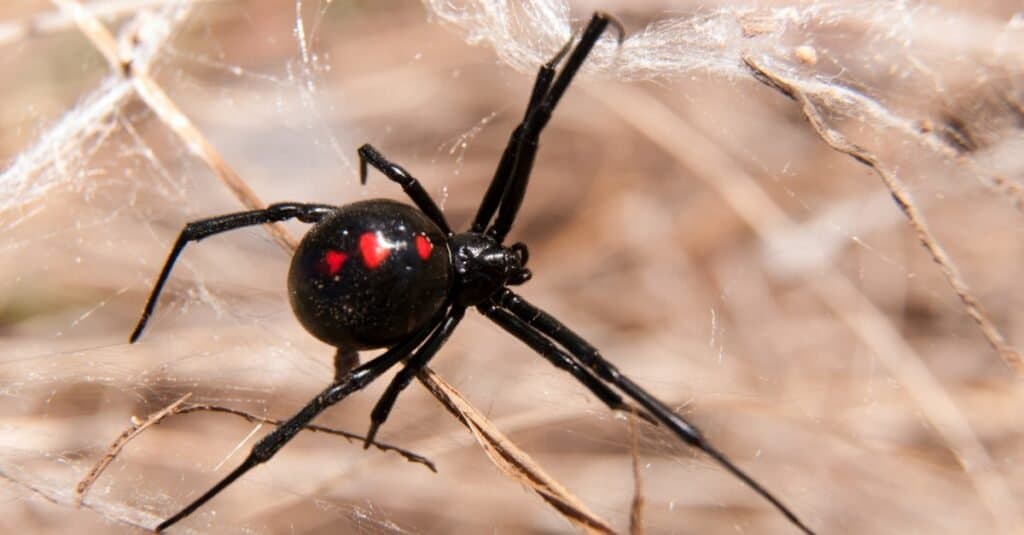
Black widow spider bites rarely kill people, but they’re incredibly painful.
©Sari ONeal/Shutterstock.com
5. Arizona Bark Scorpion
Scorpions love dry, hot desert environments and they live in all of New Mexico’s deserts.
Brown Arizona bark scorpions live in New Mexico’s deserts, despite the name, leaving the safety of burrows at night to hunt insects with two long pinchers and a venomous stinger atop a five-segmented tail. Prey includes lizards, spiders, and mice, but these dangerous scorpions have very few predators of their own.
Females reach seven inches long, but smaller males top out at three inches long. Moms carry up to 30 babies on their backs until they’re ready to fend for themselves!
Humans on the receiving end of a bark scorpion feel blistering pain, sweat, shake, and feel sick. Death is a rare event, but medical attention is important.
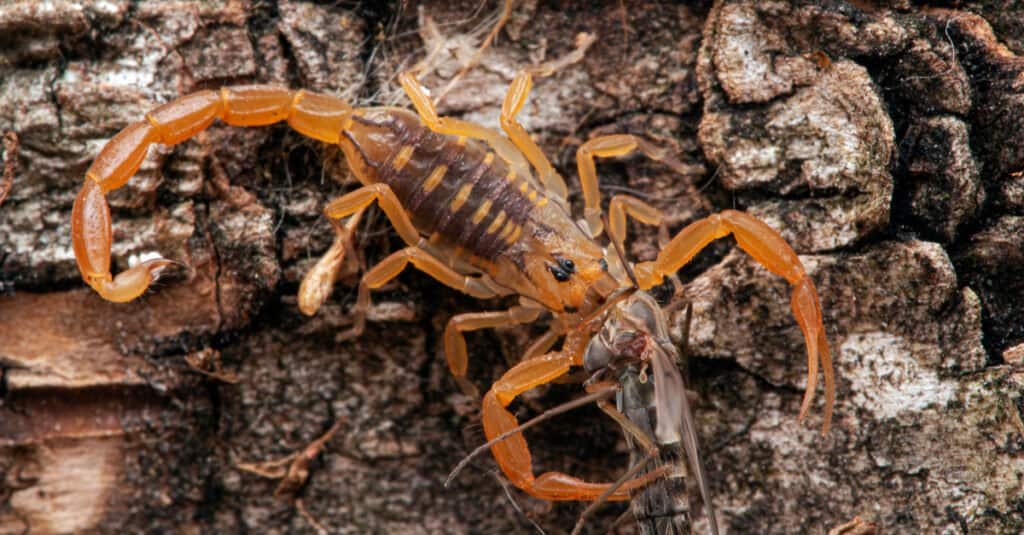
The Arizona bark scorpion hunts insects, lizards, mice, and spiders with it’s venomous stinger.
©Ernie Cooper/Shutterstock.com
6. Brown Recluse Spider
One of two venomous spiders in North America (the other is the black widow), brown recluse spiders prefer to inhabit homes, but they also live in New Mexico’s desert caves, crevices, and cool, dark hiding spots.
They prey on insects with a venomous bite and drag their prey back to a webbed nest. Birds, snakes, lizards, and tarantulas prey on brown recluse spiders, if they can find them! These clever arachnids live up to their name – they are very reclusive. Very few bites are attributed to this spider each year because it’s rare to see one.
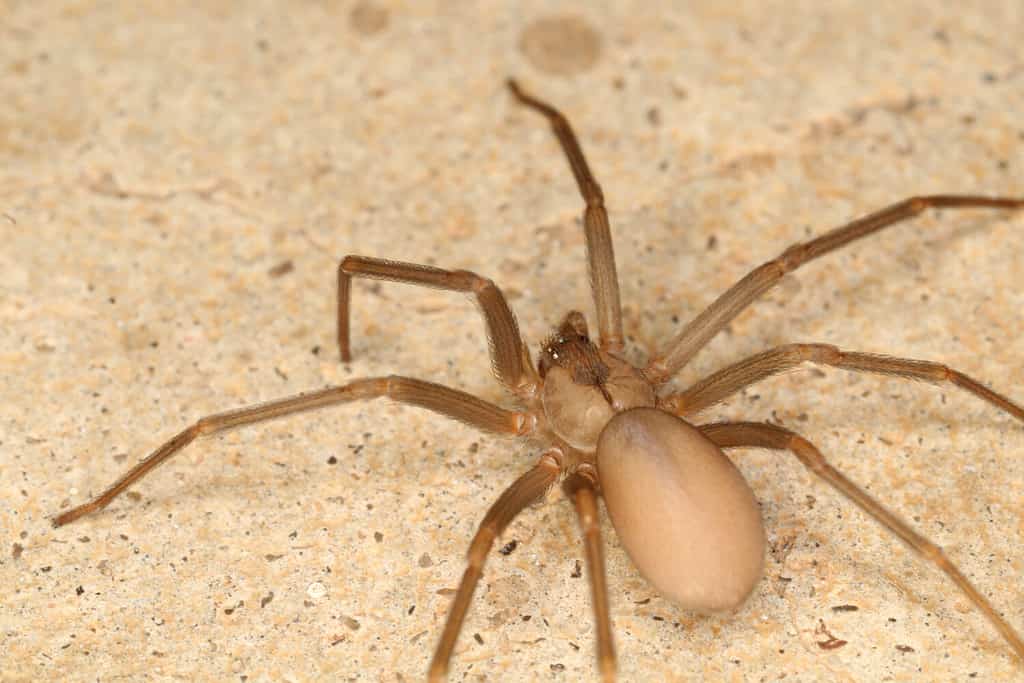
Brown recluse spiders live in the desert’s cool cracks and crevices.
©Nick626/Shutterstock.com
7. Mountain Lion
Mountain lion, cougar, puma, call it what you want, there’s no arguing this cat isn’t dangerous. It’s an epic feline with the capacity to leap 20 vertical feet and 45 feet across chasms.
4-5 foot tall pumas are more than capable of killing people, but they’re shy of contact and keep themselves hidden away. They hunt by stealth, usually rodents, birds, or snakes, and have no predators other than humans. In New Mexico’s deserts, they stick to scrublands, brush, and rocky outcrops with vantage points to survey their territory and stalk whatever they please.
Did you know that cougars cannot roar? They make cute housecat noises instead, but this does not mean you should approach one.

Mountain lions are capable of leaping 20 vertical feet, that’s the height of a two storey building!
©iStock.com/SandmanXX
8. Western Diamondback Rattlesnake
A Western Diamondback is another type of rattlesnake that’s native to New Mexico’s deserts. This incredible rattler is a dangerous snake if provoked, so never approach one and certainly don’t attempt to pick one up.
In New Mexico’s deserts, the pit viper western diamondback is a force to be reckoned with. They weigh up to 15 pounds and reach six feet long. It’s easy to identify this huge snake from the diamond pattern running the length of its body (hence the name diamondback) and the end-of-tail rattle that shakes out a warning that you’re too close.
Diamondback bites can kill humans, they’re the most venomous snake in America, but they don’t hunt us. Bites occur if they’re trodden on or if someone inexplicably tries to pick one up. Instead, this nocturnal snake hunts desert rodents and lizards, sensing body heat via a pit located behind each nostril.
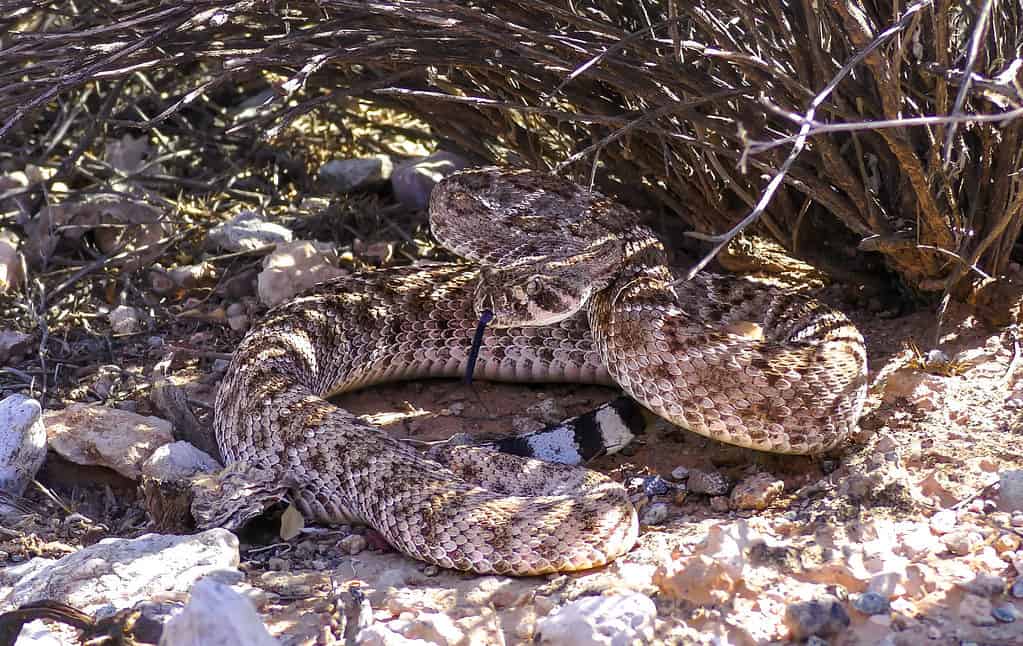
Western diamondback rattlesnakes can reach six feet long and weigh 15 pounds.
©iStock.com/Banu R
9. Prairie Rattlesnake
The prairie rattlesnake is another dangerous rattler living in New Mexico’s deserts.
This recognizable rattler has a distinctive rattling tail and triangular head, but they’re an interesting green-brown shade. This helps them blend in with the scrub and bushland they like to hide and hunt in.
At dawn and dusk, prairie rattlesnakes hunt prairie dogs, rodents, and lizards with heat-sensing pits before injecting them with potent venom and then waiting for death before swallowing the unfortunate creature whole. Like other rattlers, the prairie rattlesnake hibernates overwinter because New Mexico’s deserts are too cold for them.
A bite from one of these epic snakes is capable of killing a human, but it’s rare. Pets and children are more at risk, so if you’re visiting New Mexico’s incredible deserts during summer, keep your eyes peeled near scrub and bushland.

A prairie rattlesnake hunts prairie dogs, rodents, and lizards.
©iStock.com/Matt Kaminski
10. Golden Eagle
While not dangerous to humans, golden eagles are top predators and dangerous to any land animal small enough to be grabbed by razor-sharp talons and carried away. Golden eagles sometimes drop their prey from a height, before retrieving its broken body to eat in peace.
A golden eagle’s wingspan reaches seven feet wide, but they only weigh 12 pounds! That’s how they manage to use the desert’s hot air currents to glide over vast distances without expending too much effort.
Snakes, prairie dogs, rodents, and lizards all make a tasty meal for this glorious raptor. There’s a small nesting population in the Chihuahuan Desert.

A golden eagle’s wingspan can reach seven feet wide.
©MehmetO/Shutterstock.com
11. Coyotes
Coyote packs inhabit New Mexico’s Badlands, and their nighttime howls send shivers down the toughest human spine.
Pack canine coyotes have pointed ears and noses, long bushy tails, and golden eyes. It’s no wonder they’re also called the prairie wolf. They can run at 40 mph and weigh up to 46 pounds, but coyotes are secretive animals that shy away from humans. They don’t usually pose danger, however, a pack of wild coyotes is more than capable of killing a human and certainly their pet dog.
Their usual prey in New Mexico’s deserts consists of prairie dogs, rodents, and occasionally snakes or lizards. They’ll also eat fruit and vegetable matter they uncover on their extensive travels.
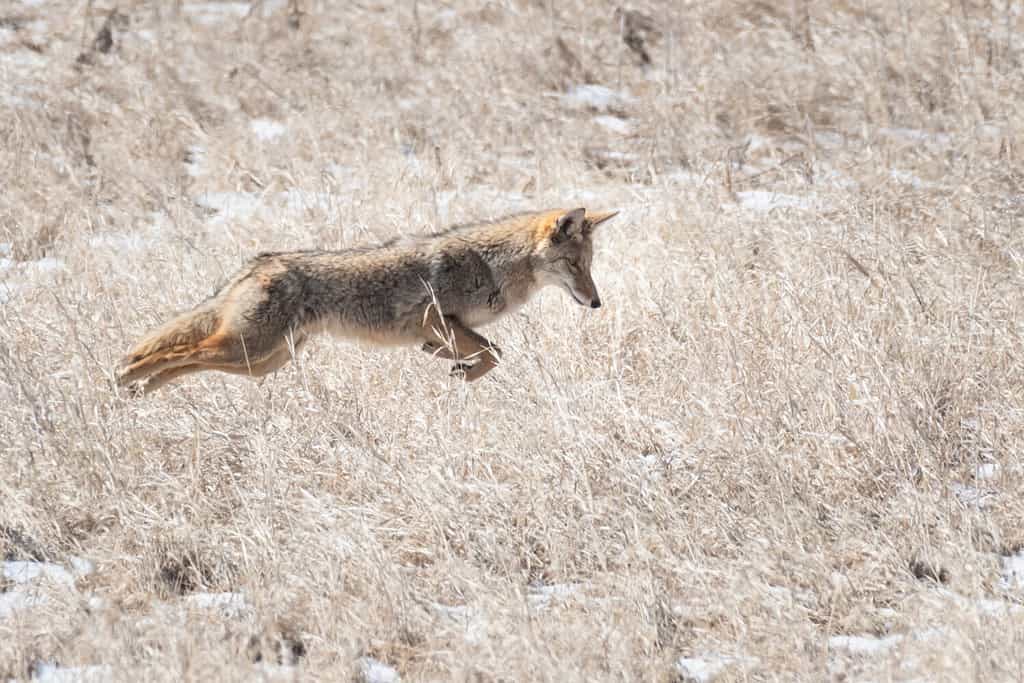
Coyotes hunt prairie dogs, rodents, and lizards in New Mexico’s deserts.
©Eivor Kuchta/Shutterstock.com
Summary of 11 Most Dangerous Animals Lurking in New Mexico
| Dangerous Animal | Reason | |
|---|---|---|
| 1. | Coral Snake | Venomous bite |
| 2. | Tarantula | Venomous bite |
| 3. | Mojave Rattlesnake | Venomous bite |
| 4. | Black Widow | Venomous bite |
| 5. | Arizona Bark Scorpion | Venomous sting |
| 6. | Brown Recluse Spider | Venomous bite |
| 7. | Mountain Lion | Can attack and kill a human |
| 8. | Western Diamondback Rattlesnake | Venomous bite |
| 9. | Prairie Rattlesnake | Venomous bite |
| 10. | Golden Eagle | Danger to small pets |
| 11. | Coyote | A pack is capable of killing a human or pet |
The photo featured at the top of this post is © John A Davis/Shutterstock.com
Thank you for reading! Have some feedback for us? Contact the AZ Animals editorial team.







